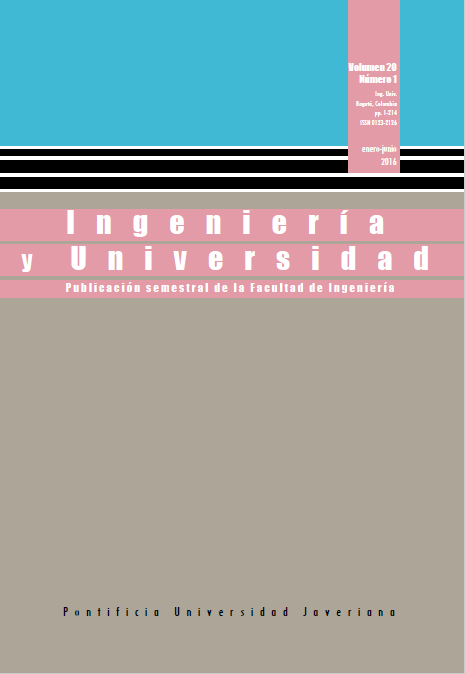Abstract
This article presents a strategy for designing optimal planar electromagnetic absorbers of several layers. The electromagnetic absorbers designed can operate in different frequency ranges. They were optimized by using a well-known spiral optimization algorithm. Results for the case of three, five, seven, and nine layers, showed the advantage of using this algorithm, mainly in terms of fewer adjustable parameters and its great capacity for intensification and diversification. Using Spiral Optimization, electromagnetic absorbers with seven and nine layers were designed for the frequency range between 0.8-5.4 GHz. They achieved a minimum attenuation of –26.13 dB and -25.66 dB, with respective thicknesses of 6.26 mm and 8.64 mm. The seven-layered design performed better tan the nine-layered one. The results obtained were compared to those reported with other global optimization methods.
[2] I. Amaya and R. Correa, “Optimal design of multilayer EMAs for frequencies between 0.85 GHz and 5.4 GHz,” Rev. Ing., vol. 38, pp. 33-37, 2013.
[3] E. Salazar and E. Mora, Diseño de absorbedores electromagnéticos óptimos utilizando optimización por enjambre de partículas y análisis de intervalos. Bucaramanga: Universidad Industrial de Santander, 2011.
[4] E. E. Salazar Flórez, J. E. Mora Moreno, and C. R. Correa Cely, “Design of optimum electromagnetic absorbers in the wireless communications range,” Ing. y Univ., vol. 18, no. 1, pp. 27-42, May 2014.
[5] S. Roy, S. D. Roy, J. Tewary, A. Mahanti, and G. K. Mahanti, “Particle swarm optimization for optimal design of broadband multilayer microwave absorber for wide angle of incidence,” Prog. Electromagn. Res. B, vol. 62, pp. 121-135, 2015.
[6] C. Lin, A. Qing, and J. Zang, “Design of wideband multilayer planar absorber using a new differential evolution algorithm,” 2015, p. 952117.
[7] J. Choi and H.-T. Jung, “A new triple-layered composite for high-performance broadband microwave absorption,” Compos. Struct., vol. 122, pp. 166-171, 2015.
[8] S.-W. Eun, W.-H. Choi, H.-K. Jang, J.-H. Shin, J.-B. Kim, and C.-G. Kim, “Effect of delamination on the electromagnetic wave absorbing performance of radar absorbing structures,” Compos. Sci. Technol., vol. 116, pp. 18-25, 2015.
[9] S. Sui, H. Ma, J. Wang, Y. Pang, and S. Qu, “Topology optimization design of a lightweight ultra-broadband wide-angle resistance frequency selective surface absorber,” J. Phys. D. Appl. Phys., vol. 48, no. 21, p. 215101, Jun. 2015.
[10] K. Sainath and F. L. Teixeira, “Perfectly reflectionless omnidirectional absorbers and electromagnetic horizons,” J. Opt. Soc. Am. B, vol. 32, no. 8, pp. 1645–1650, Aug. 2015.
[11] F. Dincer, M. Karaaslan, and C. Sabah, “Design and analysis of perfect metamaterial absorber in GHz and THz frequencies,” J. Electromagn. Waves Appl., pp. 1-9, May 2015.
[12] K. Tamura and K. Yasuda, “Spiral optimization-A new multipoint search method,” in 2011 IEEE International Conference on Systems, Man, and Cybernetics, 2011, no. 1, pp. 1759- 1764.
[13] D. Karaboga, B. Gorkemli, C. Ozturk, and N. Karaboga, “A comprehensive survey: artificial bee colony (ABC) algorithm and applications,” Artif. Intell. Rev., vol. 42, no. 1, pp. 21-57, Mar. 2014.
[14] I. Boussaïd, J. Lepagnot, and P. Siarry, “A survey on optimization metaheuristics,” Inf. Sci. (Ny)., vol. 237, pp. 82-117, Jul. 2013.
[15] I. Amaya, J. Cruz, and R. Correa, “A modified firefly-inspired algorithm for global computational optimization,” Dyna, vol. 81, no. 187, pp. 85-90, Oct. 2014.
[16] I. Amaya, J. Cruz, and R. Correa, “Harmony Search algorithm: a variant with Self-regulated Fretwidth,” Appl. Math. Comput., vol. 266, pp. 1127-1152, 2015.
[17] I. Fister Jr., X. Yang, I. Fister, J. Brest, and D. Fister, “A Brief Review of Nature-Inspired Algorithms for Optimization,” Elektroteh. Vestn., vol. 80, no. 3, pp. 116-122, 2013.
[18] K. Tamura and K. Yasuda, “Spiral Multipoint Search for Global Optimization,” 2011 10th Int. Conf. Mach. Learn. Appl. Work., vol. 2, no. 2, pp. 470-475, Dec. 2011.
[19] K. Tamura and K. Yasuda, “The Spiral Optimization and its stability analysis,” in 2013 IEEE Congress on Evolutionary Computation, 2013, pp. 1075-1082.
[20] H. Liu, L. Zhang, and Y. Gao, “Electromagnetic Wave Absorber Optimal Design Based on Improved Particle Swarm Optimization,” in International Symposium on Electromagnetic Compatibility, 2009, pp. 797-800.
[21] S. Chamaani, “Modified Multi-Objective Particle Swarm Optimization for Electromagnetic Absorber Design,” in Progress in Electromagnetics Research, PIER 79, 2008, pp. 353–366.
[22] S. Chamaani, S. A. Mirtaheri, and M. A. Shooredeli, “Design of very thin wide band absorbers using modified local best particle swarm optimization,” AEU-Int. J. Electron. Commun., vol. 62, no. 7, pp. 549-556, Aug. 2008.
This journal is registered under a Creative Commons Attribution 4.0 International Public License. Thus, this work may be reproduced, distributed, and publicly shared in digital format, as long as the names of the authors and Pontificia Universidad Javeriana are acknowledged. Others are allowed to quote, adapt, transform, auto-archive, republish, and create based on this material, for any purpose (even commercial ones), provided the authorship is duly acknowledged, a link to the original work is provided, and it is specified if changes have been made. Pontificia Universidad Javeriana does not hold the rights of published works and the authors are solely responsible for the contents of their works; they keep the moral, intellectual, privacy, and publicity rights.
Approving the intervention of the work (review, copy-editing, translation, layout) and the following outreach, are granted through an use license and not through an assignment of rights. This means the journal and Pontificia Universidad Javeriana cannot be held responsible for any ethical malpractice by the authors. As a consequence of the protection granted by the use license, the journal is not required to publish recantations or modify information already published, unless the errata stems from the editorial management process. Publishing contents in this journal does not generate royalties for contributors.



